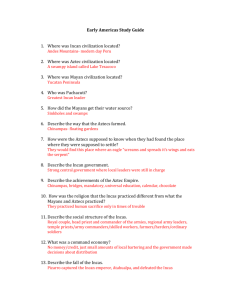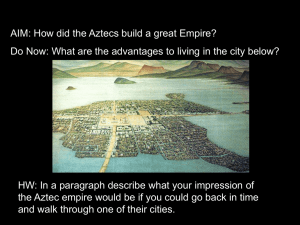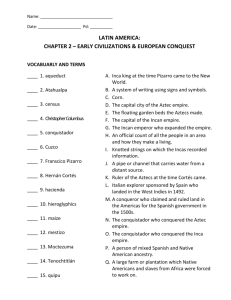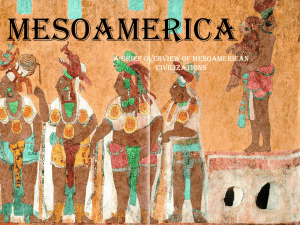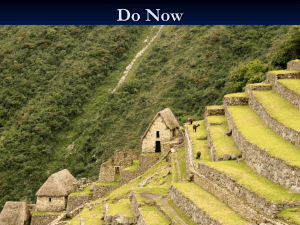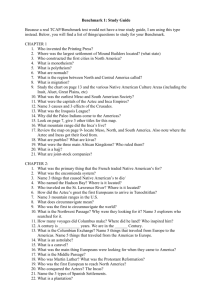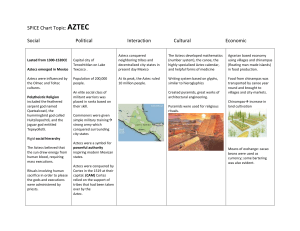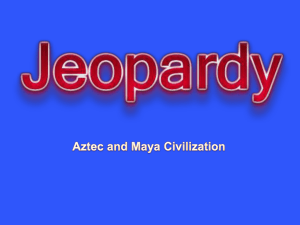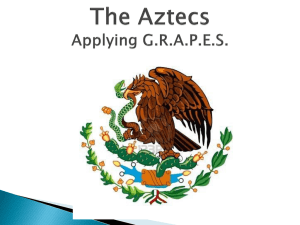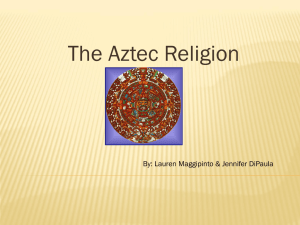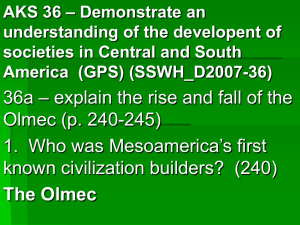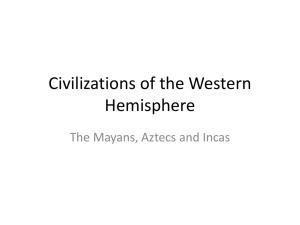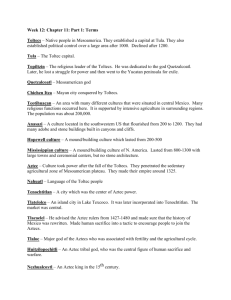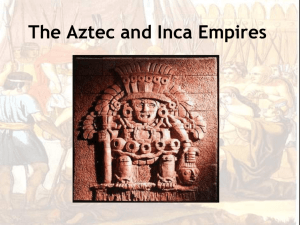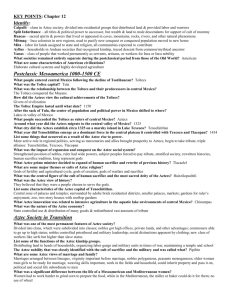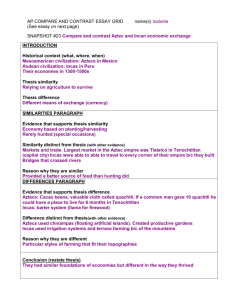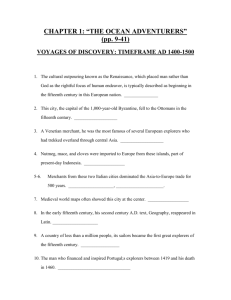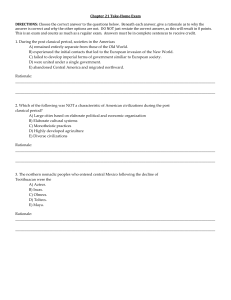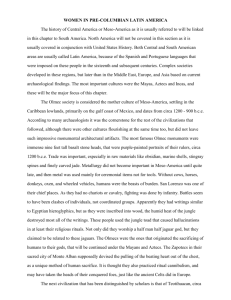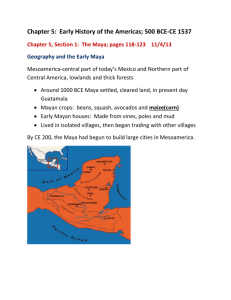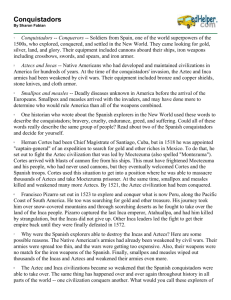Chapter 11 Review
advertisement
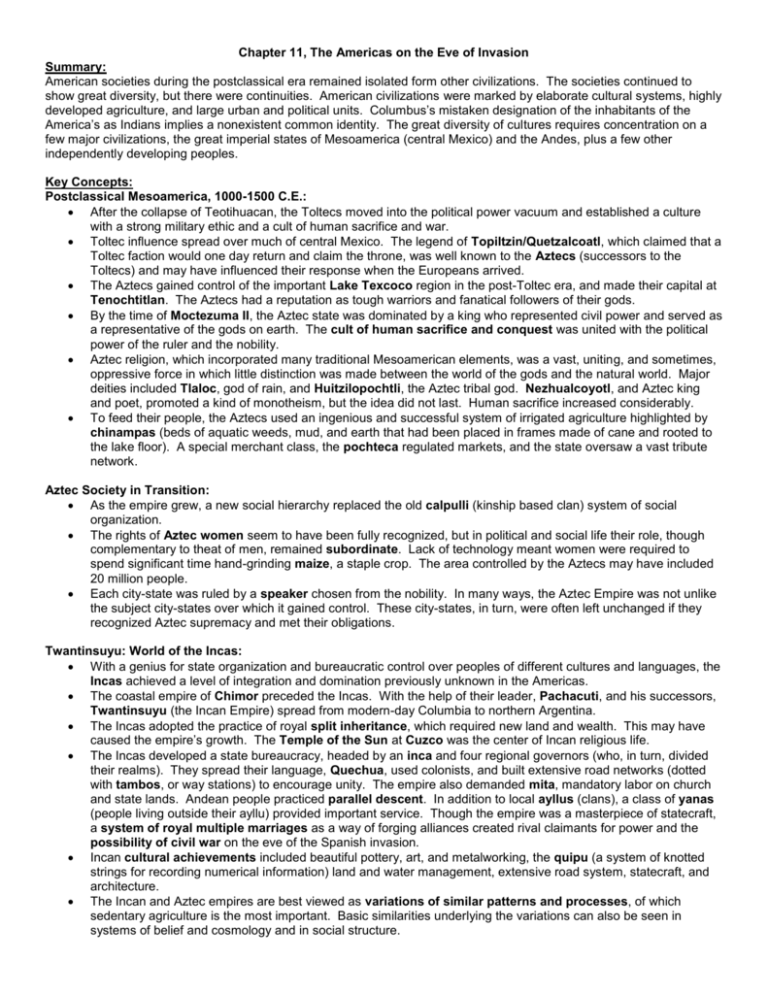
Chapter 11, The Americas on the Eve of Invasion Summary: American societies during the postclassical era remained isolated form other civilizations. The societies continued to show great diversity, but there were continuities. American civilizations were marked by elaborate cultural systems, highly developed agriculture, and large urban and political units. Columbus’s mistaken designation of the inhabitants of the America’s as Indians implies a nonexistent common identity. The great diversity of cultures requires concentration on a few major civilizations, the great imperial states of Mesoamerica (central Mexico) and the Andes, plus a few other independently developing peoples. Key Concepts: Postclassical Mesoamerica, 1000-1500 C.E.: After the collapse of Teotihuacan, the Toltecs moved into the political power vacuum and established a culture with a strong military ethic and a cult of human sacrifice and war. Toltec influence spread over much of central Mexico. The legend of Topiltzin/Quetzalcoatl, which claimed that a Toltec faction would one day return and claim the throne, was well known to the Aztecs (successors to the Toltecs) and may have influenced their response when the Europeans arrived. The Aztecs gained control of the important Lake Texcoco region in the post-Toltec era, and made their capital at Tenochtitlan. The Aztecs had a reputation as tough warriors and fanatical followers of their gods. By the time of Moctezuma II, the Aztec state was dominated by a king who represented civil power and served as a representative of the gods on earth. The cult of human sacrifice and conquest was united with the political power of the ruler and the nobility. Aztec religion, which incorporated many traditional Mesoamerican elements, was a vast, uniting, and sometimes, oppressive force in which little distinction was made between the world of the gods and the natural world. Major deities included Tlaloc, god of rain, and Huitzilopochtli, the Aztec tribal god. Nezhualcoyotl, and Aztec king and poet, promoted a kind of monotheism, but the idea did not last. Human sacrifice increased considerably. To feed their people, the Aztecs used an ingenious and successful system of irrigated agriculture highlighted by chinampas (beds of aquatic weeds, mud, and earth that had been placed in frames made of cane and rooted to the lake floor). A special merchant class, the pochteca regulated markets, and the state oversaw a vast tribute network. Aztec Society in Transition: As the empire grew, a new social hierarchy replaced the old calpulli (kinship based clan) system of social organization. The rights of Aztec women seem to have been fully recognized, but in political and social life their role, though complementary to theat of men, remained subordinate. Lack of technology meant women were required to spend significant time hand-grinding maize, a staple crop. The area controlled by the Aztecs may have included 20 million people. Each city-state was ruled by a speaker chosen from the nobility. In many ways, the Aztec Empire was not unlike the subject city-states over which it gained control. These city-states, in turn, were often left unchanged if they recognized Aztec supremacy and met their obligations. Twantinsuyu: World of the Incas: With a genius for state organization and bureaucratic control over peoples of different cultures and languages, the Incas achieved a level of integration and domination previously unknown in the Americas. The coastal empire of Chimor preceded the Incas. With the help of their leader, Pachacuti, and his successors, Twantinsuyu (the Incan Empire) spread from modern-day Columbia to northern Argentina. The Incas adopted the practice of royal split inheritance, which required new land and wealth. This may have caused the empire’s growth. The Temple of the Sun at Cuzco was the center of Incan religious life. The Incas developed a state bureaucracy, headed by an inca and four regional governors (who, in turn, divided their realms). They spread their language, Quechua, used colonists, and built extensive road networks (dotted with tambos, or way stations) to encourage unity. The empire also demanded mita, mandatory labor on church and state lands. Andean people practiced parallel descent. In addition to local ayllus (clans), a class of yanas (people living outside their ayllu) provided important service. Though the empire was a masterpiece of statecraft, a system of royal multiple marriages as a way of forging alliances created rival claimants for power and the possibility of civil war on the eve of the Spanish invasion. Incan cultural achievements included beautiful pottery, art, and metalworking, the quipu (a system of knotted strings for recording numerical information) land and water management, extensive road system, statecraft, and architecture. The Incan and Aztec empires are best viewed as variations of similar patterns and processes, of which sedentary agriculture is the most important. Basic similarities underlying the variations can also be seen in systems of belief and cosmology and in social structure. The Other Indians: The diversity of ancient America forces us to reconsider ideas of human development based on Old World examples. Population figures are difficult to pin down, but in 1500 the Americas may have had roughly the same number of inhabitants as Europe (between 57-72 million people). Chieftanships based on sedentary agriculture could be found outside the major American empires. Cultural diversity was particularly great in North America. Most American societies (outside the Incas and Aztecs) were strongly kin-based, unlike in Europe and Asia. The America contained a broad range of societies, from great civilizations with millions of people to small bands of hunters. In many of these societies, religion played a dominant role in defining the relationship between people and their environment and between the individual and society. Key Terms: Maize Cuzco Hernan Cortes Chichen Itza Inca Socialism Temple of the Sun Calpulli Pochteca Parallel Descent Tlaloc Essay Questions: 1. In what ways did the Aztecs continue the culture of the classical Mesoamerican civilization and the Toltecs? 2. Describe Aztec social organization. 3. Compare and contrast the Inca and Aztec empires in terms of political administration. 4. How did the Indian cultures outside the Andean and Mesoamerican civilization zones contrast in political and social organization with the Aztec and Inca empires? 5. How have historians explained the existence and prevalence of human sacrifice among the Aztecs?
